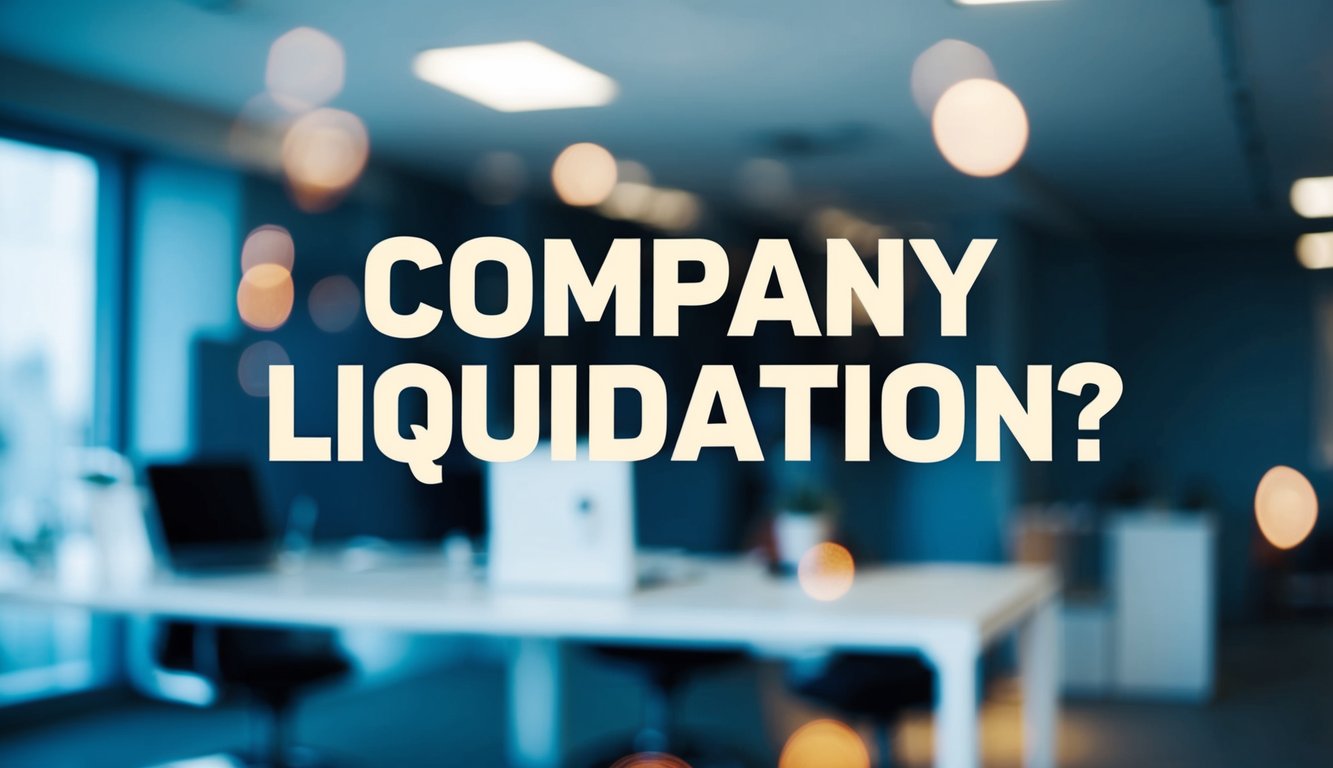
Company Liquidation: Meaning and Implications – A Comprehensive Guide for Business Owners
What Is Liquidation in Business?
Company liquidation is the process of winding up a business and selling its assets to settle debts. It often sadly marks the end of a company’s operations and leads to its formal closure.
Formal Definition of Company Liquidation
Company liquidation refers to the legal procedure of dissolving a business entity. During this process, the company’s assets are sold off, and the proceeds are used to pay creditors. Any remaining funds are distributed among shareholders.
Liquidation can be voluntary or compulsory. Voluntary liquidation occurs when directors and shareholders choose to close the company. Compulsory liquidation happens when creditors force the company into closure through court action.
Purpose and Objectives of Liquidation
The primary purpose of liquidation is to bring a company’s affairs to an orderly end. This process aims to maximise the value of assets for creditors and shareholders.
Key objectives include:
- Selling company assets
- Settling debts with creditors
- Distributing any surplus funds to shareholders
- Investigating the conduct of directors
- Closing the company’s legal existence
Liquidation protects creditors’ interests by ensuring fair treatment in debt repayment. It also provides a clear exit strategy for companies that are no longer viable or needed.
Free Consultation – advice@andersonbrookes.co.uk or call on 0800 1804 935 our freephone number (including from mobiles).
Liquidation – Google Review

Types of Liquidation Explained
Company liquidation comes in three main forms, each suited to different circumstances. These types vary in their initiation, process, and outcomes for the business and its stakeholders.
| Feature | Creditors’ Voluntary Liquidation (CVL) | Members’ Voluntary Liquidation (MVL) | Compulsory Liquidation |
|---|---|---|---|
| Trigger | Company insolvent – voluntary | Company solvent – voluntary | Court order from a creditor |
| Control | Initiated by directors/shareholders | Initiated by shareholders | Controlled by the court |
| Creditors Paid? | Based on asset value | Paid in full | Based on asset value |
| Director Risk | Scrutiny over trading history | Minimal | High risk of investigation |
| Common Use | Business can’t pay debts | Exiting a solvent company | Enforced debt collection |
Creditors’ Voluntary Liquidation (CVL)
A CVL occurs when a company’s directors recognise it can’t pay its debts and decide to wind up the business. This process begins with a shareholders’ resolution, followed by appointing a licensed insolvency practitioner as liquidator.
In a CVL, the liquidator’s primary duty is to realise the company’s assets and distribute the proceeds to creditors. This type of liquidation offers some control to directors whilst protecting creditors’ interests.
CVLs can help directors avoid accusations of wrongful trading and potential personal liability. It’s often seen as a responsible action when a company faces insurmountable financial difficulties.
The Creditors’ Voluntary Liquidation Process
We can place a company into liquidation within 8 days of instruction.
Compulsory Liquidation
This type of liquidation is initiated by creditors through a court order. It typically occurs when a company owes £750 or more and has failed to pay after receiving a statutory demand.
The court appoints an official receiver to manage the liquidation process. They investigate the company’s affairs, realise assets, and distribute funds to creditors.
Compulsory liquidation can have serious consequences for directors. The official receiver scrutinises their conduct, which may lead to disqualification if misconduct is found.
This process is often seen as a last resort and can be more damaging to a company’s reputation than voluntary liquidation.
Members’ Voluntary Liquidation (MVL)
An MVL is used when a solvent company wishes to close down. It’s initiated by shareholders and requires a declaration of solvency from directors.
This process allows for the orderly winding up of a company that has reached the end of its useful life or when shareholders wish to extract value from the business.
In an MVL, all creditors are paid in full, and any remaining assets are distributed to shareholders. This can be tax-efficient, as distributions may qualify for entrepreneurs’ relief.
An insolvency practitioner oversees the process, ensuring all legal requirements are met and maximising returns for shareholders.

The Liquidation Process In the UK
Liquidation involves a structured process to wind up a company’s affairs and dissolve its legal entity. It requires careful management to ensure fair treatment of all stakeholders.
Initiation of Liquidation Proceedings
The liquidation process begins when a company’s directors or creditors decide to wind up the business. For voluntary liquidations, shareholders pass a special resolution. In compulsory liquidations, creditors petition the court.
Once initiated, the company must cease trading immediately. Directors lose control over company affairs and assets. All employees are typically made redundant, though some may be retained temporarily to assist the liquidator.
The company must notify Companies House and HMRC of the liquidation. Public notices are placed in the Gazette to inform creditors and the public.
Role of the Liquidator
A licensed insolvency practitioner is appointed as liquidator to oversee the process. Their primary duties include:
- Taking control of company assets
- Investigating the company’s affairs
- Realising assets for creditors’ benefit
- Distributing proceeds to creditors
- Ensuring compliance with legal requirements
The liquidator acts as an independent party, working in creditors’ interests. They have broad powers to carry out their duties, including selling assets, pursuing legal claims, and investigating directors’ conduct.
Asset Realisation and Distribution
The liquidator catalogues and values all company assets. These are then sold through various means:
- Public auctions
- Private sales
- Online marketplaces
Proceeds are distributed to creditors according to a strict order of priority:
- Secured creditors
- Preferential creditors (e.g. employees)
- Unsecured creditors
- Shareholders (if any funds remain)
The liquidator provides regular updates to creditors on the progress of asset realisation and distribution. Once all assets are realised and funds distributed, the company is formally dissolved.
Legal & Financial Consequences of Liquidation
Company liquidation carries significant legal consequences that affect various stakeholders. The process involves complex legal procedures and obligations that must be carefully navigated.
Impact on Directors and Shareholders
Directors face heightened scrutiny during liquidation. You may be investigated for wrongful or fraudulent trading if you continued operating whilst insolvent. Personal liability is possible if misconduct is proven.
Disqualification from acting as a director for up to 15 years can occur in severe cases. Your powers cease upon appointment of a liquidator, who takes control of the company.
Shareholders typically lose their investment and voting rights. You’re last in line for any remaining assets after creditors are paid. Limited liability usually protects you from company debts, unless you’ve provided personal guarantees.
Consequences for Creditors
Secured creditors have first claim on assets tied to their security. You can enforce your rights through legal action or by appointing a receiver.
Unsecured creditors often receive little or no repayment. You must submit proof of debt to the liquidator. Legal action against the company is stayed, preventing individual debt collection.
Preferential creditors like employees have priority for certain debts. You rank above unsecured creditors but below secured ones. The liquidator distributes available funds according to this legal hierarchy.
Effects on Employees
Your employment contract terminates upon liquidation. You become a preferential creditor for unpaid wages (up to £800) and holiday pay.
You may claim statutory redundancy pay if you’ve worked for the company for over two years. The government’s Redundancy Payments Service can step in if the company can’t pay.
TUPE regulations don’t apply in liquidation, so your job isn’t automatically transferred to a new owner. You’ll need to claim any outstanding payments through the liquidator or government schemes.

Alternatives to Liquidation
Companies facing financial difficulties have several options besides liquidation. These alternatives can help businesses restructure their debts, continue operating, and potentially recover from insolvency. Let’s explore three key alternatives:
Company Voluntary Arrangements (CVAs)
A CVA is a formal agreement between a company and its creditors to repay debts over an extended period. This option allows you to continue trading whilst managing your debts.
Key features of CVAs:
- Supervised by an insolvency practitioner
- Typically last 3-5 years
- Require approval from 75% of creditors by value
- Can reduce or restructure debts
CVAs offer flexibility in repayment terms and can help you avoid liquidation. However, they require careful planning and commitment to the agreed terms.
Administration
Administration is a process where an insolvency practitioner takes control of your company to rescue it as a going concern or achieve a better result for creditors than immediate liquidation.
Benefits of administration:
- Provides a statutory moratorium, protecting the company from creditor action
- Allows for restructuring and potential sale of the business
- Can result in better outcomes for creditors and employees
During administration, you lose control of your company, but it may emerge as a viable business or be sold to new owners.
Informal Creditors’ Agreements
An informal creditors’ agreement is a non-binding arrangement between your company and its creditors to repay debts over time.
Advantages of informal agreements:
- Less costly than formal insolvency procedures
- More flexible terms can be negotiated
- Avoids public disclosure of financial difficulties
These agreements rely on trust between you and your creditors. They can be effective for smaller companies with fewer creditors but may be challenging to implement for larger businesses with complex debt structures.
Signs That a Company May Need Liquidation
Companies facing severe financial distress may need to consider liquidation. Recognising these signs early can help owners and directors make informed decisions about the future of their business.
Insolvency Indicators
Insolvency is a primary sign that liquidation might be necessary. You’re considered insolvent if your company can’t pay its debts when they’re due or if your liabilities exceed your assets.
Look for:
- Negative cash flow statements
- Declining profit margins
- Increasing debt levels
If you’re consistently unable to pay suppliers or staff on time, it’s a red flag. Creditors chasing payments or threatening legal action are also serious indicators.
Consider seeking professional advice if you notice these signs. An insolvency practitioner can assess your situation and advise on potential options.
Persistent Cash Flow Problems
Cash flow is the lifeblood of any business. Persistent issues in this area often signal deeper financial troubles.
Warning signs include:
- Regularly relying on overdrafts
- Difficulty paying rent or utilities
- Constantly juggling payments to creditors
If you’re frequently unable to take advantage of supplier discounts due to lack of funds, it’s concerning. Similarly, if you’re struggling to invest in necessary equipment or stock, your cash flow might be critically low.
Consider creating detailed cash flow forecasts to identify patterns and potential shortfalls. This can help you make informed decisions about your company’s future.
Inability to Meet Financial Obligations
When your company consistently fails to meet its financial obligations, liquidation may be on the horizon.
Key indicators include:
- Defaulting on loan repayments
- Missing tax payments to HMRC
- Accumulating unpaid invoices from suppliers
If you’re receiving final demand notices or court summons for unpaid debts, it’s a serious situation. Likewise, if you’re considering taking out high-interest loans just to cover day-to-day expenses, your financial health is at risk.
It’s crucial to act quickly if you’re facing these issues. Ignoring them won’t make them go away and could lead to compulsory liquidation. Seek professional advice to explore all available options for your company.

Liquidation Support from Anderson Brookes
Anderson Brookes offers specialised assistance for companies considering liquidation. Our team provides expert guidance, personalised advice, and free initial consultations to help you navigate the complex process.
We assist with:
- Assessing your company’s financial situation
- Explaining the implications of liquidation
- Preparing necessary documentation
- Liaising with creditors on your behalf
Our advisers work closely with you to develop a plan that best suits your company’s situation and goals – ensuring compliance.
Liquidation Google Reviews

&

Questions? Speak to an expert today! 0800 1804 935
You may also be interested in:
Liquidation FAQs
Company liquidation raises many important questions for business owners, creditors and employees. The process involves complex legal and financial considerations with significant implications.
What are the consequences for directors after a company’s liquidation?
Directors’ powers cease once liquidation begins. Their conduct may be investigated, especially in cases of insolvency. If found to have acted improperly, directors could face disqualification or personal liability.
What reasons might lead to a company’s liquidation?
Common reasons include insolvency, declining profits, market changes, or strategic decisions. Some companies liquidate voluntarily to close down operations and distribute remaining assets to shareholders.
How does liquidation affect the company’s employees?
Employees typically lose their jobs when a company enters liquidation. They become preferential creditors for unpaid wages and may be eligible for redundancy payments from the government.
What are the different categories of company liquidation?
The main types are compulsory liquidation, creditors’ voluntary liquidation, and members’ voluntary liquidation. Each has distinct procedures and applies in different circumstances.
What is the most cost-effective method to liquidate a company?
A members’ voluntary liquidation is often the most cost-effective for solvent companies. For insolvent firms, creditors’ voluntary liquidation may be less costly than compulsory liquidation.
How is liquidation defined within the realm of accounting?
In accounting terms, liquidation involves selling company assets, settling liabilities, and distributing any remaining funds to shareholders. It marks the end of a company’s financial existence.

